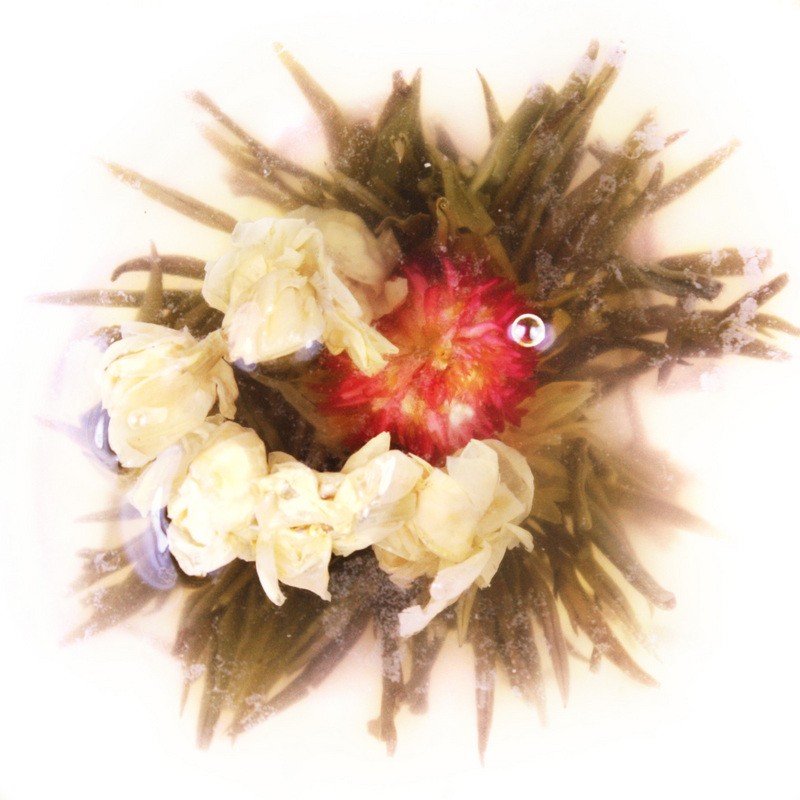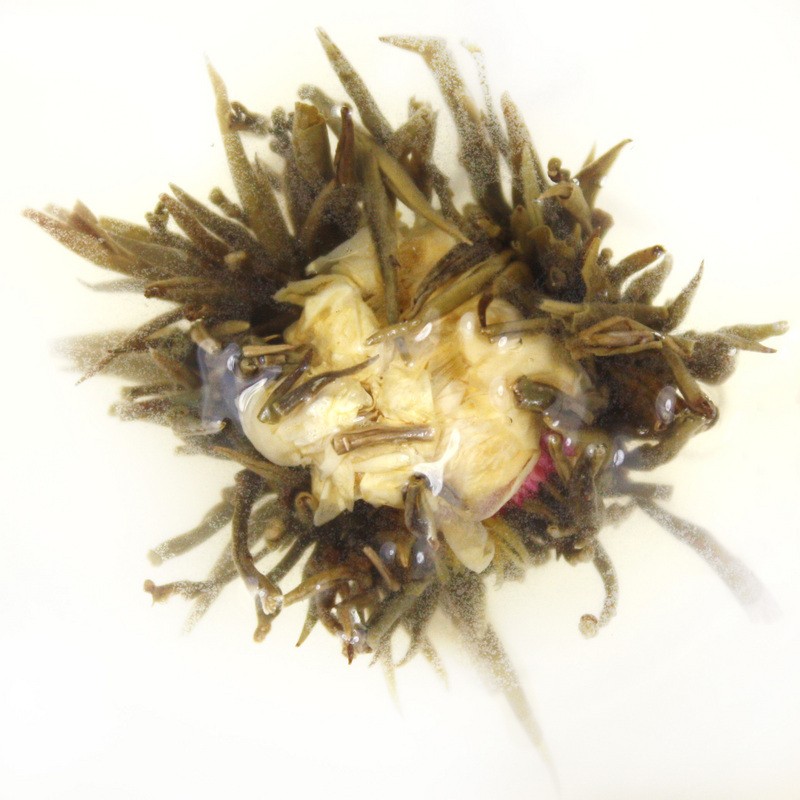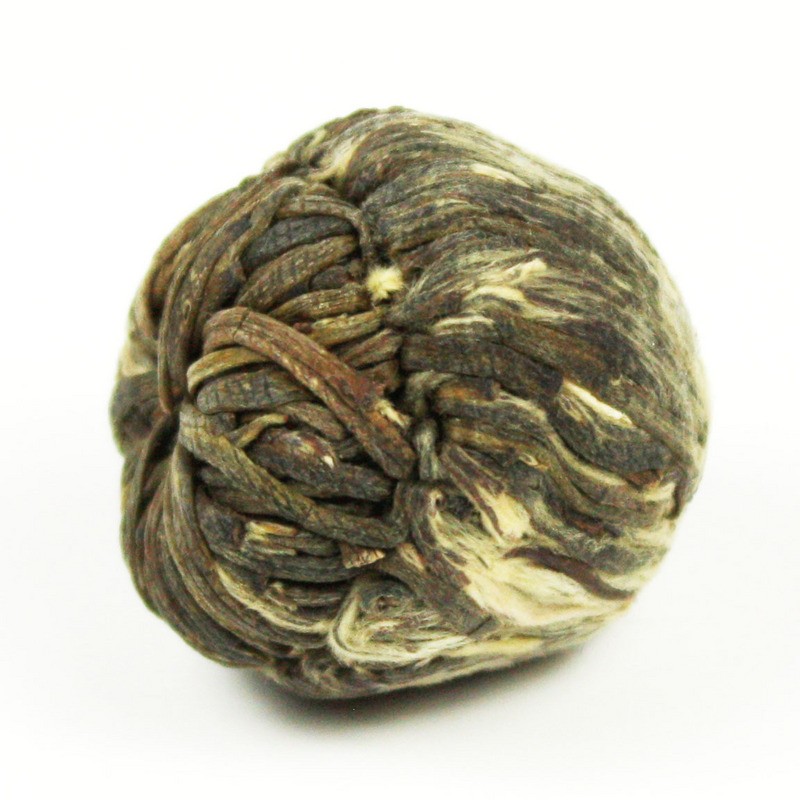White Tea Brewing Guide

1 Teaspoon
Add 1 teaspoon per person and one for the pot.

70⁰c - 80⁰c
Boil using fresh water, at a temperature of 70⁰c - 80⁰c.

2 - 3 Mins
Steep for 2 - 3 minutes, depending on personal preference.
About Product
-
Product Description
This stunning Chinese Tea Flower is a handmade creation of striking quality. When placed in a glass vessel to brew, the outer Tea leaves burst open to reveal a string of beautiful yellow chrysanthemum flowers. Seldom can one experience such majesty when brewing up a cup of Tea!
This incredible Flowering Tea, also known as Treasure Tea and Blooming Tea, is as enchanting in taste as it is in appearance. It originates from the Fujian province of China (similar to most Flowering Teas), where experienced workers can make up to 400 of these Teas a day!
White Tea in This Flowering Tea
White Tea is the least processed type of any Tea – even over Green Tea. Contrary to popular belief, it does not come from the light liquor it produces. Instead, it stems from the silvery pekoe (hairs or dust) that grow on the unopened buds of the Tea leaf used in its making.
Its processing (or, rather, lack of), coupled with its short oxidation period, results in a brew that is unmistakably delicate and very fresh. The most common White Teas are Yinzhen (Silver Needle), Bai Mu Dan (White Peony) and Shou Mei.
Chrysanthemum in This Flowering Tea
China is home to 17 different species of this captivating flower. Two of the most used species, Chrysanthemum indicum and Chrysanthemum morifolium, grow predominantly in the provinces of Anhui, Gansu, Henan, Jiangxi, Shaanxi and Zhejiang.
Traditional Chinese Medicine (TCM) has long used chrysanthemum to treat symptoms of cold and flu. According to this age-old holistic medicine practice, the flower can also disperse wind and heat; clear “liver fire”; promote vision; and offer relief from dizziness and skin sores.
TCM has also recognised the flower as one of the keys to longevity! This is because of the fascinating life of Empress Dowager and Regent Cixi (1835-1908), who outlived the eight emperors who had preceded her. She enjoyed consuming chrysanthemum, too!
Useful Information
Type of Tea: Flowering Tea (White Tea).
Origin: China.
Brewing Instructions: Brew using water at a temperature of approximately 90 degrees while watching the Tea flower unfold. Some choose to brew it several times.
How to Serve: This beverage tastes best as it is.
Tasting Notes: Expect delicate tastes with refined floral notes.
Colour in Cup: Pale Green liquor with yellow highlights, light in tone.
Health Benefits of Flowering Tea
Flowering Tea looks so alluring when brewing. But did you know that the White Tea found in this beverage can help you, too, to maintain your looks? A recent study by BioMed Central established that White Tea has antioxidant activity that directly affects the overall health and appearance of skin. Researchers looked specifically at the effects of White Tea on structural proteins found in the skin called elastin and collagen.
They concluded: “White tea whole extract exhibits comparable anti-elastase activity to EGCG alongside very high collagenase [enzymes that break the peptide bonds in collagen] inhibition at a very small final concentration of 25 μg which suggests additive or synergistic activity between the catechins within the tea extract particularly in the case of collagenase inhibition.
Also, as collagenase is a zinc-containing metalloproteinase, the catechins within the tea extract which are known to be metal chelators may bind to the Zn2+ ion within the enzyme thus preventing it from binding with the substrate.”
-
Delivery Information
We offer reliable delivery services through Royal Mail to ensure that your orders reach you on time.
Here are the main points you should be aware of:
- Standard UK Delivery: £3.95 excluding delivery charge.
- Delivery Times: Orders are processed and dispatched within 2-5 working days but they may take longer during busy times. It is worth noting that all our orders are packed by hand in order to maintain the quality.
- Free Delivery: We are delighted to provide free shipping for UK orders over £35*. Moreover, customers from Europe can enjoy free shipping for any purchase above €75*. Furthermore, we offer free delivery in the USA for all purchases exceeding $125*. Please note terms and conditions may apply.
- Tracking: When your package is sent you will receive a tracking number via email so as to keep tabs of its progress.
International Shipping
We do ship worldwide meaning our products can be accessed by anyone around the world.
Here are some important details:
- Delivery Times: International deliveries vary based on destination, generally taking between 7-14 working days.
- Shipping Costs: International shipping costs are calculated at checkout based on your location and weight of your order. View full delivery charges for your location.
- Customs and Import Duties: Remember customs or import duties may exist depending on regulations in your country; these charges are borne by the customer.
Returns Policy
Your satisfaction is our top priority, however if for any reasons you’re not completely happy with your purchase, simply follow our returns procedure:
- Eligibility: Items returned within 30 days of receipt must remain unopened and in their original condition.
- Process: In order to return an item contact our customer service department using your unique order number after which detailed instructions will be given concerning returning them back to us securely.
- Refunds: Our aim is to refund you within 5-7 working days upon successful reception of returned goods. The refund amount will be credited to your original payment method.
For any other Enquiries or help please contact our Customer Support Team always at your service.
-
Product Reviews

 Loose Leaf Tea
Loose Leaf Tea Pyramids
Pyramids Tea Bags
Tea Bags Africa
Africa Assam
Assam Ceylon
Ceylon Chinese
Chinese Darjeeling
Darjeeling European
European Indian
Indian Japan
Japan Nepal
Nepal South East Asia
South East Asia Ayurveda Tea
Ayurveda Tea Black Tea
Black Tea Chai Tea
Chai Tea Flowering Tea
Flowering Tea Fruit Tisanes
Fruit Tisanes Green Tea
Green Tea Herbal Tea
Herbal Tea Matcha Tea
Matcha Tea Oolong Tea
Oolong Tea Organic Tea
Organic Tea Pu erh Tea
Pu erh Tea Rooibos Tea
Rooibos Tea White Tea
White Tea Asian Coffee
Asian Coffee Caribbean Coffee
Caribbean Coffee Central American Coffee
Central American Coffee South American Coffee
South American Coffee Coffee Blends
Coffee Blends Decaffeinated Coffee
Decaffeinated Coffee Espresso Coffee
Espresso Coffee Ethically Sourced Coffee
Ethically Sourced Coffee Flavoured Coffee
Flavoured Coffee Organic Coffee
Organic Coffee Single Origin Coffee
Single Origin Coffee Chocolate 1
Chocolate 1 Chocolate 2
Chocolate 2 Chocolate 3
Chocolate 3 Chocolate 4
Chocolate 4 Chocolate 5
Chocolate 5 Chocolate 6
Chocolate 6 Chocolate 7
Chocolate 7 Chocolate 8
Chocolate 8 Chocolate 9
Chocolate 9 Loose Tea Filters
Loose Tea Filters Tea Accessories
Tea Accessories Tea Bricks
Tea Bricks Tea Caddies
Tea Caddies Tea Caddy Spoons
Tea Caddy Spoons Tea Gift Ideas
Tea Gift Ideas Tea Infusers
Tea Infusers Tea Strainers
Tea Strainers




